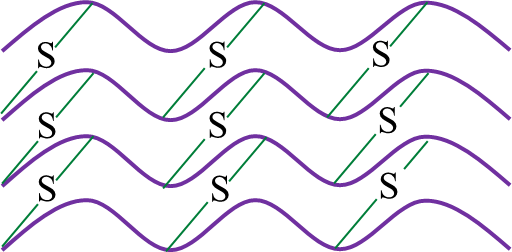[adinserter block="3"]
Question 7:
Diagram 7.1 shows various use of synthetic rubber.
 Diagram 7.1
Diagram 7.1
(a) Based on Diagram 7.1, state the major use of synthetic rubber. [1 mark]
[adinserter block="3"]
(b) State two characteristics of synthetic rubber which is used to make shoe soles. [2 marks]
(c) Diagram 7.2 shows the formation of vulcanised rubber.
 Diagram 7.2
Diagram 7.2
(i) What is process R? [1 mark]
(ii) Draw the structure of vulcanised rubber in the space provided on Diagram 7.2. [1 mark]
(iii) State one function of sulphur in the formation of vulcanised rubber. [1 mark]
[adinserter block="3"]
Answer:
(a) Tyre
(b)
1. Heat resistant
2. Hard
3. Water resistant
(Choose any two)
(c)(i) Vulcanisation
(c)(ii)

(c)(iii) To prevent rubber polymer from sliding with each other
Diagram 7.1 shows various use of synthetic rubber.
 Diagram 7.1
Diagram 7.1(a) Based on Diagram 7.1, state the major use of synthetic rubber. [1 mark]
[adinserter block="3"]
(b) State two characteristics of synthetic rubber which is used to make shoe soles. [2 marks]
(c) Diagram 7.2 shows the formation of vulcanised rubber.
 Diagram 7.2
Diagram 7.2(i) What is process R? [1 mark]
(ii) Draw the structure of vulcanised rubber in the space provided on Diagram 7.2. [1 mark]
(iii) State one function of sulphur in the formation of vulcanised rubber. [1 mark]
[adinserter block="3"]
Answer:
(a) Tyre
(b)
1. Heat resistant
2. Hard
3. Water resistant
(Choose any two)
(c)(i) Vulcanisation
(c)(ii)

(c)(iii) To prevent rubber polymer from sliding with each other
[adinserter block="3"]
Question 8:
Diagram 8.1 shows word equation of the soap making process.
 Diagram 8.1
Diagram 8.1
(a) What is the name of the soap making process? [1 mark]
(b) Give one example of substance X. [1 mark]
[adinserter block="3"]
(c) Diagram 8.2 shows the structure of a soap molecule.
Name the part Y and Z in the boxes provided in Diagram 8.2 using the following words given. [2 marks]
 Diagram 8.2
Diagram 8.2
[adinserter block="3"]
(d) A student found that her clothes stained with dirt.
Arrange the following cleansing actions of soap in the correct sequence in the boxes provided. [2 marks]

[adinserter block="3"]
Answer:
(a) Saponification
(b) Palm oil
(c)
Y: Hydrophilic
Z: Hydrophobic
(d)

Diagram 8.1 shows word equation of the soap making process.
 Diagram 8.1
Diagram 8.1(a) What is the name of the soap making process? [1 mark]
(b) Give one example of substance X. [1 mark]
[adinserter block="3"]
(c) Diagram 8.2 shows the structure of a soap molecule.
Name the part Y and Z in the boxes provided in Diagram 8.2 using the following words given. [2 marks]
 Diagram 8.2
Diagram 8.2[adinserter block="3"]
(d) A student found that her clothes stained with dirt.
Arrange the following cleansing actions of soap in the correct sequence in the boxes provided. [2 marks]

[adinserter block="3"]
Answer:
(a) Saponification
(b) Palm oil
(c)
Y: Hydrophilic
Z: Hydrophobic
(d)

 Diagram 5.1
Diagram 5.1

 Diagram 5.2
Diagram 5.2 Diagram 6.1
Diagram 6.1 Diagram 6.2
Diagram 6.2 Diagram 3
Diagram 3 Diagram 1
Diagram 1 Table 1
Table 1

 Diagram 2
Diagram 2 Table 2
Table 2 (Speed is derived from dividing distance by time.)
(Speed is derived from dividing distance by time.)












 TIPS: In SPM, you MUST remember all 5 base quantities and its SI unit.
TIPS: In SPM, you MUST remember all 5 base quantities and its SI unit.